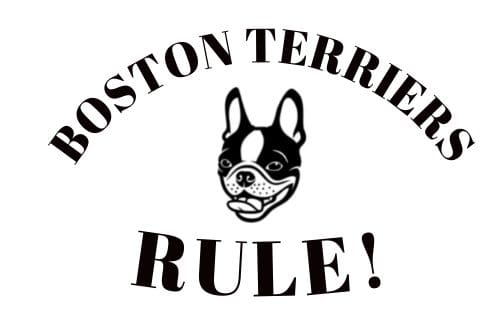Eye Popping Out, Eye Bulging (Proptosis) in Boston Terriers: Causes, Emergency Steps, and Treatment Options
Proptosis, a distressing condition where a dog’s eye is forced out of its socket, is a traumatic event commonly associated with injuries or trauma to the eye or its surrounding structures.
Boston Terriers, like many other dog breeds, can experience their eye popping out, eye bulging (proptosis) due to various reasons such as head trauma, fights, or excessive pressure on the eye.
In this article, I discuss the causes of eyes bulging, eyes popping out, a.k.a. proptosis, and emergency steps to take if your Boston Terrier’s eye has popped out. Treatment options, costs associated with treatment, and the possibility of saving a ruptured eye in dogs. For more information on Boston Terrier eye health and issues, click here.

Understanding Proptosis in Boston Terriers
Proptosis in dogs, including Boston Terriers, is a severe medical condition characterized by the protrusion or popping out of the eye from its normal position within the eye socket. This event can occur due to significant injuries or trauma to the eye, head, or the surrounding area.
Common causes of proptosis include head trauma from accidents, fights, or excessive pressure on the eye, leading to the displacement of the eyeball from its natural position.

4 Immediate Actions to Take in Case of Proptosed Eye
If you find yourself facing the harrowing situation of your Boston Terrier’s eye popping out or bulging, it is of utmost importance to stay calm and act swiftly to ensure the well-being of your dog.
Here are the immediate steps you should take:
1. Stay Calm: Remaining calm is essential to provide the best care for your dog in this critical situation. Panicking can only worsen the situation, so take deep breaths and focus on the steps ahead.
2. Handle with Care: Handle your dog gently and be cautious not to apply pressure on the affected eye. The eye is a delicate organ, and excessive pressure can cause further harm.
3. Protect the Eye: If possible, carefully cover the eye with a clean, damp cloth to protect it from any further trauma or irritation. This will also help keep the eye moist, which is crucial for its health.
4. Seek Emergency Veterinary Care: Waste no time and immediately contact your veterinarian or head to the nearest emergency veterinary clinic for prompt evaluation and appropriate treatment. Time is of the essence in cases of proptosis, and quick action can potentially save your dog’s eye and reduce the risk of complications.

Treatment Options for Proptosed Eye
The treatment for a proptosed eye will vary based on the severity of the injury. Veterinary intervention is critical in all cases to assess the extent of damage and determine the appropriate treatment plan. Common treatment options for proptosis include:
Manual Repositioning:
In less severe cases, a veterinarian may attempt to gently reposition the eye back into its socket. This procedure should be performed promptly and carefully to prevent further damage. Proptosis in these delightful dogs demands immediate attention and appropriate treatment. The initial step in treating a proptosed eye is often manual repositioning, particularly in less severe cases.
Veterinarians employ their expertise to gently and carefully guide the eye back into its socket. This procedure must be conducted swiftly to minimize the risk of further damage to the eye and surrounding tissues. The delicate nature of the eye requires a precise and gentle touch, highlighting the importance of seeking professional help promptly.
Surgery:
In more severe cases where the eye cannot be repositioned manually, surgical intervention is often necessary. Surgery is performed to carefully reposition the eye and address any underlying damage to the structures surrounding the eye.
Surgical correction is often the recommended approach, especially for Boston Terriers facing a severe proptosis event. The surgical procedure involves a meticulous repositioning of the eye and addressing any damage to the surrounding structures.
This process aims to restore the eye to its proper position within the socket, minimizing discomfort and potential vision loss for the affected Boston Terrier. The surgical team works diligently to ensure the best possible outcome, considering the unique anatomy and needs of the Boston Terrier’s eye during the procedure.
Post-surgical care is equally vital to facilitate a smooth recovery and enhance the likelihood of a successful reintegration of the eye, allowing the Boston Terrier to return to a happy and active life.

Cost Considerations for Proptosis Treatment
The cost of treating eye proptosis in dogs can vary depending on several factors, including the severity of the condition, the need for surgery, geographical location, and the specific veterinary clinic.
Generally, surgical interventions and subsequent care can be quite expensive. It is crucial to consult with your veterinarian to discuss treatment options and associated costs, ensuring that you make informed decisions that prioritize your dog’s health and well-being.


Addressing Ruptured Eye and Its Outlook
In cases where the eye has ruptured, the outlook for saving the eye largely depends on the extent of the injury and the overall health of the dog. Swift and appropriate action is vital. Some possible outcomes and interventions include:
Surgical Repair: Depending on the extent of the rupture, surgical repair may be attempted to salvage the eye. The success of this procedure depends on the degree of damage and how quickly the dog receives medical attention.
Enucleation (Eye Removal): In severe cases where the eye is extensively damaged and cannot be salvaged, enucleation may be necessary to prevent further pain and complications. This involves the surgical removal of the affected eye, which can alleviate pain and discomfort for the dog.
Surgical repair is a crucial option when addressing a ruptured eye in Boston Terriers. The success of this procedure largely depends on the severity of the rupture and the timeliness of receiving medical attention.
The veterinary surgeon will carefully evaluate the extent of the damage, considering factors such as the depth and location of the injury within the eye. In cases where the rupture is less severe and the injury is confined to a specific area, surgical repair may involve suturing and stabilizing the damaged tissues. This meticulous approach aims to restore the eye’s integrity and function, providing the potential for the eye to regain some level of vision and comfort for the affected dog.
Additionally, the post-operative care and follow-up play a vital role in the success of the surgical repair. After the surgical intervention, a comprehensive care plan, including medication, follow-up appointments, and monitoring, is essential for the dog’s recovery.
Owners must diligently adhere to the prescribed post-operative care instructions provided by the veterinarian. Regular follow-ups allow the veterinarian to assess the progress of healing, make any necessary adjustments to the treatment plan, and ensure the best possible outcome for the Boston Terrier’s eye health and overall well-being.
The support and commitment of the pet owner in this critical period significantly contribute to the success of the surgical repair and the dog’s ability to lead a comfortable life.

Conclusion
Proptosis in Boston Terriers is a distressing condition that demands immediate attention and appropriate care. Understanding the causes, recognizing the signs, and taking prompt action can significantly impact the outcome for your pup.
Remember to stay calm, handle your dog gently, protect the eye, and seek emergency veterinary care if you suspect proptosis. Always prioritize your Boston Terrier’s health and consult with a veterinarian for the best guidance and treatment options tailored to your dog’s specific situation.
Being proactive and attentive to your dog’s needs can make a crucial difference in their recovery and overall quality of life.

This post contains affiliate links. I earn from qualifying Amazon purchases.




